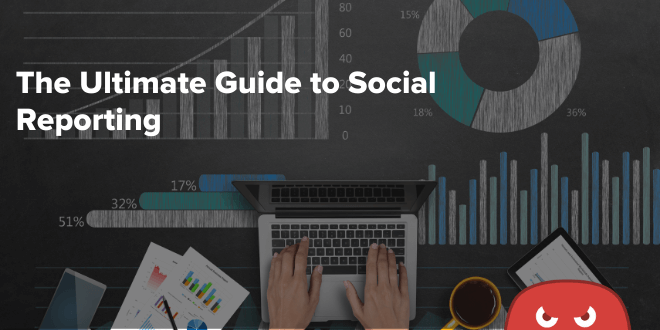Quick Links
You’re ramping up your social media efforts. You’re sharing content, posting on a schedule, and seeing the results.
Now, you have a ton of data to work with. You need a way to organize and monitor that data so you can understand how you’re doing and make improvements to your strategy.
In other words, you need to start doing some social reporting.
In this article, we’ll discuss several ways social media reporting can help you improve your social strategy and your business as a whole. Then, we’ll cover the basic pieces of a formal social media report before offering some tips on creating yours.
What Is Social Media Reporting?
As of 2018, nearly 77% of small businesses used social media for several key functions. Post-pandemic, that number is likely even higher. And no wonder, there are almost 4 billion consumers on social media in 2022.
But social media brings in a lot of data every minute, and you need to understand that data to stay ahead of your competitors on social.
Social reporting is how you measure, organize, and present your social media data to gain useful insights. This can be as informal as a spreadsheet with basic data points or a neat, organized report with charts and paragraphs discussing key insights.
Social media reports might be needed for various purposes, which can influence how much effort is required to make one. For instance, you may simply be curious if your current strategy is working and if improvements need to be made.
On the other hand, you might need a more formal report to justify to executives in your company why you should continue with a campaign.
Why Social Reporting is So Critical
Social media reporting helps you understand how you’re doing across each individual social channel, helping you improve several aspects of your social marketing.
Here are some benefits of social reporting:
Optimize your social listening strategy
Social media listening involves monitoring what people are saying about your brand across social channels, looking for broader trends, and strategizing how you’ll respond.
Naturally, social media reporting plays a crucial role in optimizing your social listening strategy. A good social media report will include brand mention data, discuss trends, and dive into explaining why those trends might exist.
This makes it easier to formulate response templates for various types of brand mentions and methods of addressing potential PR crises, among other things, on social media.
Create better content
Social media is an excellent place to share content — whether directly, through posts, or by linking to other content assets.
But to continually improve that content, social media reporting comes in handy.
You can see what content subjects and types get the most clicks, shares, replies, and other forms of engagement. Then, you can create more of that content.
For instance, maybe you learn that a certain content pillar gets a lot of clicks and retweets on Twitter. Investing more time and resources into that subject matter could pay off.
Since social SEO plays a large role in search engine rankings these days, this will bleed over into your search engine efforts as well.
CTA: Need more help with your SEO efforts? Schedule a free call with one of our SEO consultants today.
Improve your post scheduling
The quality of your posts and content are critical, but you also need to get it out at the right times to get the maximum number of eyeballs on it.
Social reporting helps you with that if you’re testing different posting times.
As an example: a social media report could show that publishing your content during the weekdays at 5:30 pm — right when many are getting done with work — gets more engagement than a 2:30 pm publishing time.
Learn more about your customers
Creating a social report helps you see trends in what your customers respond to and engage with — and how they do so.
By investigating these types of posts, you can learn more about your customers. You can find out information about their goals and problems, and how they speak about these things.
That way, you can better tailor your offers and marketing toward their needs and craft social media copy that “speaks their language” better.
Identify and invest in your top platforms
Facebook and YouTube are the top 2 social media platforms in 2022, so you may be focusing on these platforms at the moment.
But you never know, your customers may use other platforms at a higher rate — and maybe they’re more likely to interact with your brand on those platforms.
Social reporting can help you figure this out for sure. You can pick apart the data on each platform and potentially discover that some platforms offer more ROI than others.
Similarly, you can test new social media networks you don’t yet have a presence on, then create regular social reports to see if they’re worth investing in.
Justify social media campaigns
Social media campaigns cost money, so you need to prove there’s a potential return on investment — especially if you have business partners who are reluctant about it.
Creating a detailed social media report helps you prove to them that your strategy is bringing in more customers and growing the business.
Plus, being transparent about any potential flaws or less-than-stellar results and how you’ll address them can increase the confidence of clients or internal stakeholders.
6 Sections to Include in Your Social Media Report
Technically, a social media report can be as informal as numbers on a spreadsheet with a few brief insights. Those are easy to create.
However, you’ll want to create a more formal and visually appealing report if you need to show these numbers to anyone else.
So below, we’re going to explain each section of a formal social media report.
Executive summary
You want to design your report to be readable for both skimmers and people who want to read the entire thing.
That’s what the executive summary is for.
The executive summary gives a brief overview of the entire report and lists a few of the most important insights. You’ll want to mention the report’s purpose and include a few top data points, key insights, the main takeaway, and any planned action steps.
At the same time, avoid diving into the nitty-gritty details — that’s what the rest of the report is for.
Introduction
The introduction will seem similar to the executive summary, but it doesn’t cover actionable insights. Instead, it summarizes the report’s purpose and lists your main social media goals along with relevant comments.
That way, anyone reading the report knows what your data points mean as they get to the later sections.
Performance snapshot
In this section, you’ll want to list a few broad data points or KPIs (key performance indicators) regarding your social media performance. These should be relevant to your goals and the metrics you’re measuring, but don’t get into the fine details yet.
For example, you might list your net new follower count over the period you’re reporting for, total post shares, website visitors, and total conversions generated.
However, you wouldn’t break any of these down yet. That’s for the next section.
Data deep-dive
Here’s where you get deep into the numbers. Essentially, you want to include all the data relevant to the goals you’re aiming for.
Beyond that, you should also compare performance across these metrics to past periods of the same length. For instance, if this is a monthly report, include data from previous months. This will help you visualize trends.
If your report is for a specific campaign, you can also get past data from when you ran similar campaigns to see how you performed. This will be helpful in fine-tuning these campaigns for the future. In monthly and annual reports, analyze the impact on sales and revenue as well, not just soft metrics like followers.
Analysis/Discussion
Now, you have to interpret the data. You want to look for patterns in the data and analyze the impact of different channels and strategies.
For instance, you might notice higher click-through rates on certain posts. Digging deeper, you discover that these posts were all video content about a particular topic.
That could tell you that video content and this subject matter should be a focus when it comes to sharing on social media.
You can also use this section to explore why your performance was better or worse than past campaigns, helping you find ways to improve in the future.
Conclusion
Finally, briefly summarize the data mentioned and insights gained from the report. Also, include a few sentences about how you’ll use the report’s findings to craft and refine future social media strategies. You can even boil things down to a few best practices, and use them to guide future campaigns.
How to Create a Solid Social Media Report
A good social media report should strike a balance between informative, appealing, and digestible.
Here are some tips to make a social report that manages to nail all three.
Know your audience
Not your company’s audience, but your report’s audience.
If you’re preparing this for yourself or a close business partner for routine reporting, you don’t need to be as formal. You can be much more frank about any negatives as well.
However, maybe you include this report in a proposal while seeking a new partner in the business.
In that case, put extra effort into making it visually appealing. Plus, you should change the language of the report to be more persuasive. For instance, emphasize the positive and focus on how you’ll address any negatives.
Define your social media KPIs
You can’t include every single metric in your report, or you’ll waste time and distract your readers. Many metrics aren’t that important anyway.
Instead, define your few most hard-hitting KPIs and focus on these. You want a lot of data in your report, but that data needs to provide you with tangible insights — and you can do that by diving deep into the few most important metrics.
Pick a time frame and reporting schedule
You also need to outline the period you’re measuring because this influences how extensive the report is.
You can run reports every day, but these will likely not offer many valuable insights. Instead, they could simply help you judge ongoing campaign progress. A good mix is to do one weekly and one monthly report.
Weekly reports let you see any immediate trends and results of your posts and strategies. Running a monthly report will allow you to identify larger trends within campaigns or overall social media performance, giving you deeper insights.
Find a good social analytics and reporting tool
It’s pretty tough to manage all social media data flying your way without a good reporting tool.
You want to pick a tool that can easily integrate with every channel you use and offers strong analytics capabilities — like Buffer Analytics, Hootsuite, or others. But make sure it lets you add as many users as you need to see your custom social reports.
It may also be a good idea to invest in a tool that lets you schedule posts to your social accounts as well. This can streamline your social media operations and save you money on other tools.
Regardless, make sure you know exactly what features you need so you don’t overpay for things you won’t use.
Get the formatting right
Formatting a report goes a long way in ensuring people actually read the whole thing and understand what it’s conveying.
That means striking a good balance between text, white space, and visuals like graphs and charts. The latter especially can help break up the report and make it more readable while helping the reader get more out of the report.
Each section should have a clear heading, and feel free to use bold text and eye-catching colors to emphasize certain points.
Tactics like these can help readers gain the essentials while skimming and make it easy to read through and learn the details behind the top insights.
Understand and Use Your Social Data Effectively
You can’t take your social media efforts very far if you aren’t creating social media reports. Social reporting helps you learn more about your customers to optimize your social listening strategy.
As a result, you can create better content and schedule it to be shared at the right times on the right platforms.
Of course, social is just one part of a strong, omnichannel marketing strategy. If you need help understanding your SEO and PPC results (and improving your ROI on those channels), contact our digital marketing experts today.














good article